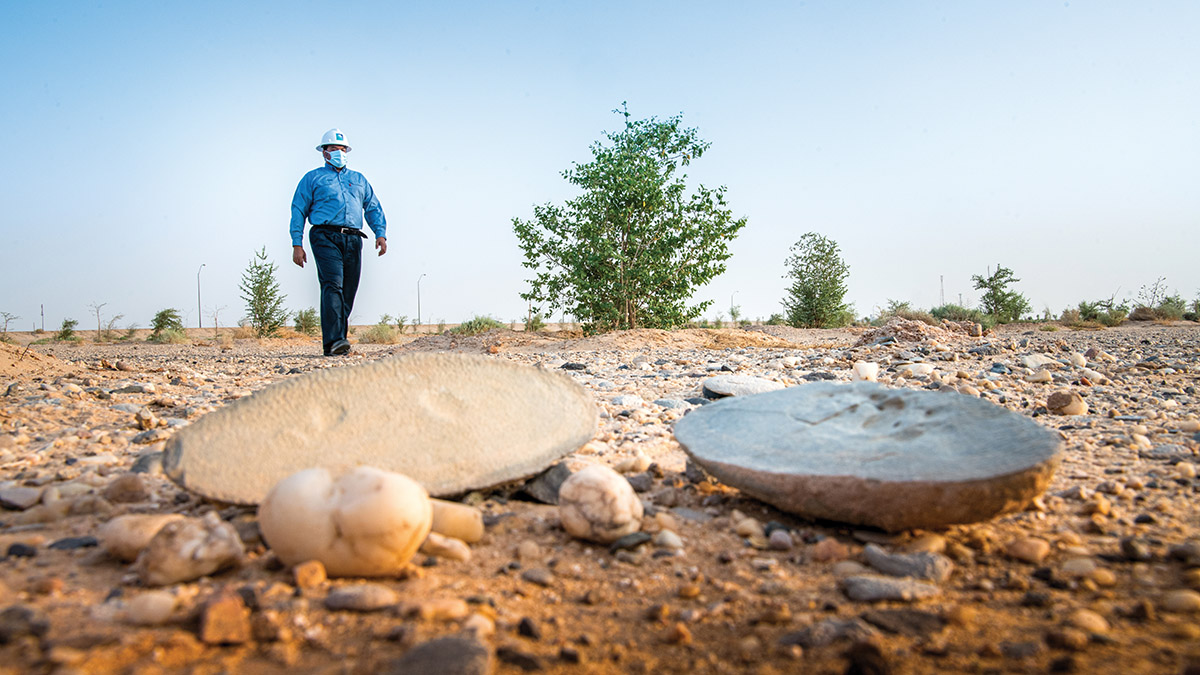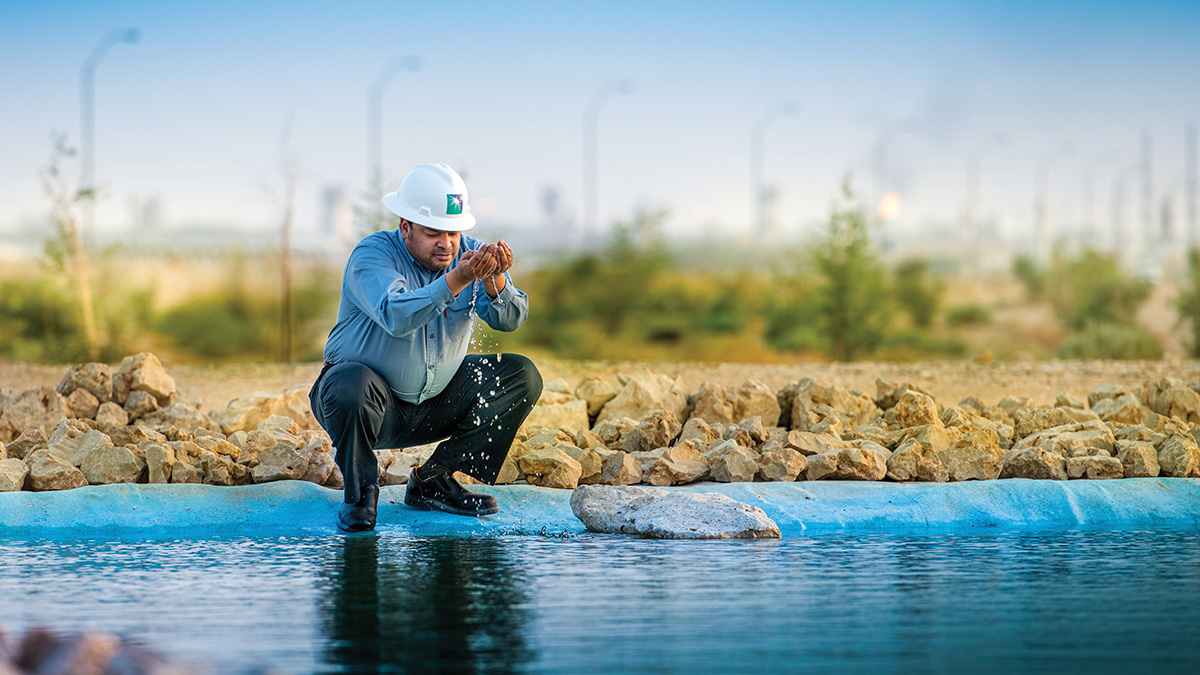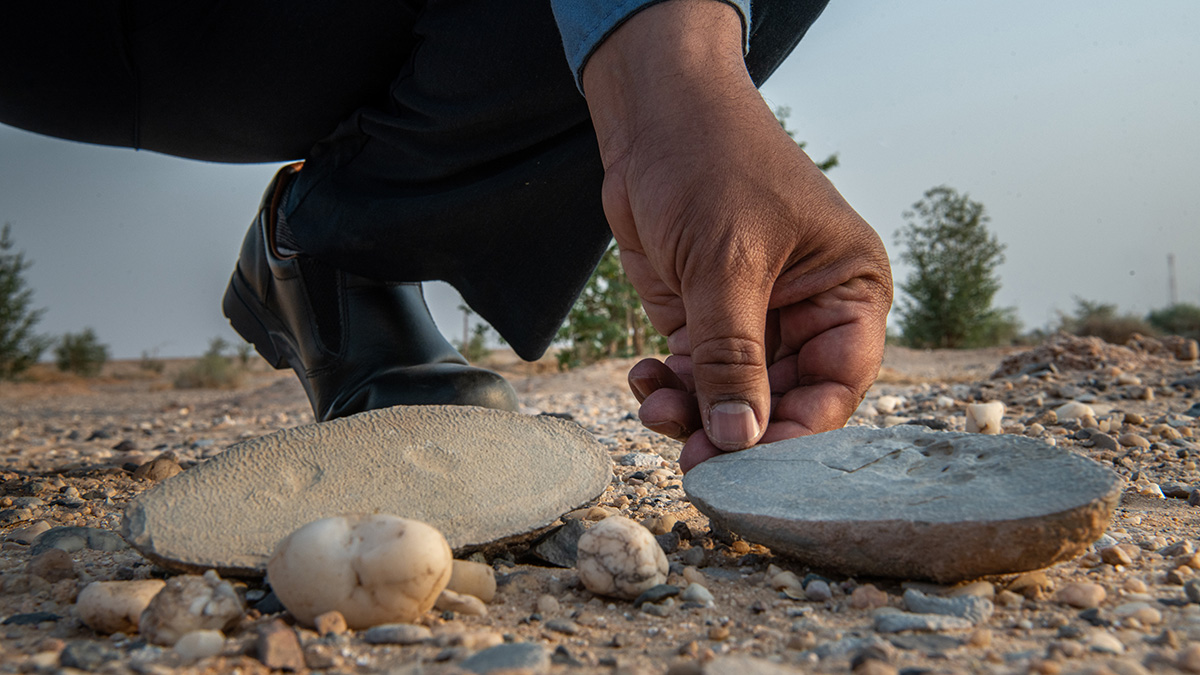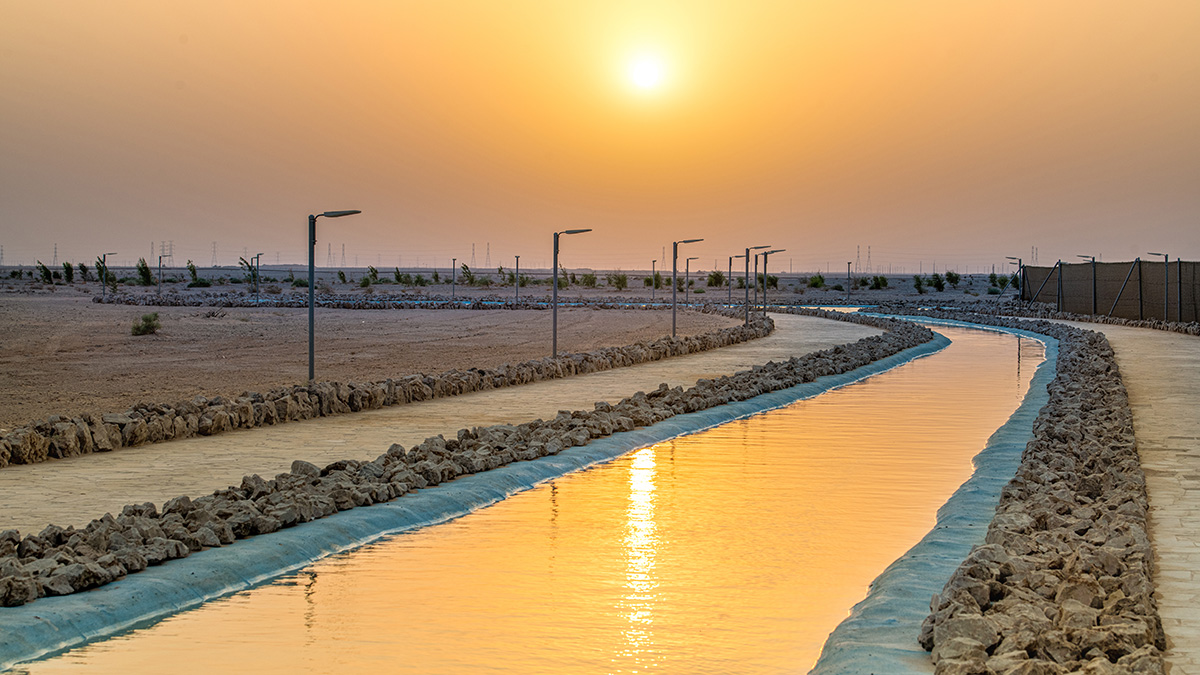Combating desertification
Inspirational replanting of desert biodiversity in Haradh

Global October 14, 2020 - By
In the southern center of Saudi Arabia’s ad-Dahna desert, river pebbles of all sizes, colors, and shapes crunch softly under your feet. The ancient rocks, tangled in the creamy sands of a land where no permanent rivers run, silently tell the history of one of the Kingdom’s longest wadis, Sahba. During the wet season, Wadi Sahba flowed for 380 kilometers (km) from Al Kharj to Al Hamar Sabkha, and since 2004, the Haradh gas plant (HdGP) has sat on her age-old open plains.
Haradh, emerging proudly from the desert sands about 270 km southeast of Riyadh, is a 32 km2 remote site processing mostly nonassociated gas from the southern area fields. Intriguingly, in the plant’s distant shadow survives three crucial pockets of native Saudi Arabian biodiversity, collectively covering 8.3 km2.
The surviving pockets, located between the gas plant and the residential community, testify to Haradh’s management of its greenhouse gases. Invaluably, seeds from the native biodiversity are aiding with Haradh’s reestablishment of a new 250,000-m2 environmental restoration area.
Bringing back desert biodiversity
The delicate edges of a late September northern wind carries the promise of winter coolness as it curves across Wadi Sahba’s age-old riverbed. Swirling toward HdGP, the wind gusts around 3,000 flourishing native trees, whose roots were gently sunk 18 months ago into the desert sands of the site’s new restoration area — named “Saudi Aramco Haradh Biodiversity Area” (SAHBA) to honor Wadi Sahba.
Sixteen species of native and endangered shrubs grow alongside the area’s trees, while the bold showpiece is a shining 700-m2 wastewater pond whose underwater surface thrives with nutritious algae.
Gas Operations vice president Abdullah M. Ghamdi inaugurated the Haradh Biodiversity area in early 2019, and says Aramco is assisting Saudi Arabia to combat desertification, sequester carbon, and enhance biodiversity.
“Haradh gas plant’s leading effort to restore nature in the desert is contributing toward the Kingdom’s wider efforts to restore its biodiversity,” said Ghamdi.
The new trees and plants at Haradh also bring business benefits such as sequestering carbon, reducing the amount of sand blowing into the plant, and creating an attractive area for our employees.
— Abdullah M. Ghamdi
Carefully planned restoration
Planning is critical to the successful restoration of biodiversity. To achieve sustainability, reintroduced fauna and flora needs to live in harmony with the natural balance of the area. So Haradh planted the right trees — and at the right time; the Kingdom’s “1 Million Trees” program technical committee advised on what trees to cultivate.
The selection of suitable trees was very carefully done, and included consulting with plantation specialists on the perfect choice of tree types that would survive to create the desired environmental system.
After a lengthy process of reviewing hundreds of tree types, 16 species of trees were carefully selected, including Acacia ehrenbergiana, Acaci nailotca ssp indica, Acacia tortilis, Acacia etbaica, Acacia gerrardii, Acacia raddiana, Acacia seyal, Balanites aegyptica, Ceratonia silique, Faidherbia albida, Maerua crassifolia, Tamarix aphylla, Tamarix passerinoides var Macrocarpa, Ziziphus spina-christi, Lawsonia inermis, and Salvadora persica.
Biodiverse and eco-friendly
An eco-friendly approach was taken to SAHBA, with its car park and pathways created organically from the area’s natural gravel surface. Water is the heartbeat of life in the desert, and the restored area’s wastewater pond has two 36-panel solar powered pumps, which sustain the flora through buried irrigation pipes. To support night creatures, light pollution is minimized with solar powered lighting only on the perimeters. Although only 18-months young, SAHBA shows nature’s talent to regenerate.
Habitat loss, disturbance and overgrazing have impacted many areas of Saudi Arabia. Aramco’s biodiversity areas are considered some of the most biologically varied areas in the Kingdom. Within the company areas, 10 have been formally designated “Aramco Biodiversity Protection Areas,” and these total 977 km2 of land.
Trees best for getting greener
The desert has a rich ecosystem, and Haradh’s first step toward preservation was controlling off-road driving, and removing waste. HdGP environmental coordinator Alawi Alsayed says there are easy ways individuals can contribute to a greener environment, noting, “Preserving the biodiversity and the animals surrounding us will enrich our lives and provide a good balance in life.”
Advising against off-road driving, Alsayed said it harms biodiversity by “damaging the habitat for birds and insects that represent a complete ecosystem.”
On greening our surroundings, Alsayed said, “The best way is to plant as many native trees as we can. We can start by planting our gardens, our streets when applicable, and inside our homes.”
Every drop saved
HdGP environmental coordinator AbdulRahman O. Lashkar is one of the team members working with Haradh’s environmental restoration.
It is deeply rewarding to see SAHBA come to life.
— AbdulRahman O. Lashkar
Lashkar studied at King Fahd University of Petroleum and Minerals joined Aramco in 1998.
“My family will continue to live in the world, and it feels like I have contributed to a legacy of restoring a piece of the planet. Imagine the impact if everyone planted two or three trees around their home,” he adds.
Aramco sponsored Lashkar in 2013 to study environmental sciences in Scotland.
“Energy is the backbone of modern life, and Aramco works to reserve resources for future generations,” Lashkar says. “With oil and gas, we take from the environment, but we also compensate, and give back.
“We save every drop of water.”
Make Saudi Arabia greener
• Plant a tree
• Do not over hunt
• Never cut down trees
• Don’t drive off-road.
River rocks, thousands of years old and in all shades of white, gray, cream, and black, lie at the site of an environmental reawakening in Haradh, honoring the Kingdom’s ancient, but now dry, Wadi Sahba.
Inspecting the solar panels powering Haradh gas plant’s (HdGP) restored biodiversity area, HdGP manager Fahad S. Dossary says it is important the world collectively lightens its environmental footprint.
Top of the page caption: Tangled in the ad-Dhana desert's southern creamy sands are river pebbles left behind by an ancient wadi. The Haradh Gas Plant sits on Wadi Sahba's age-old banks, and environmental coordinator AbdulRahman O. Lashkar is one of the team working to reestablish an inspiring 250,000-m2 area of environmental restoration to the remote operating site.






